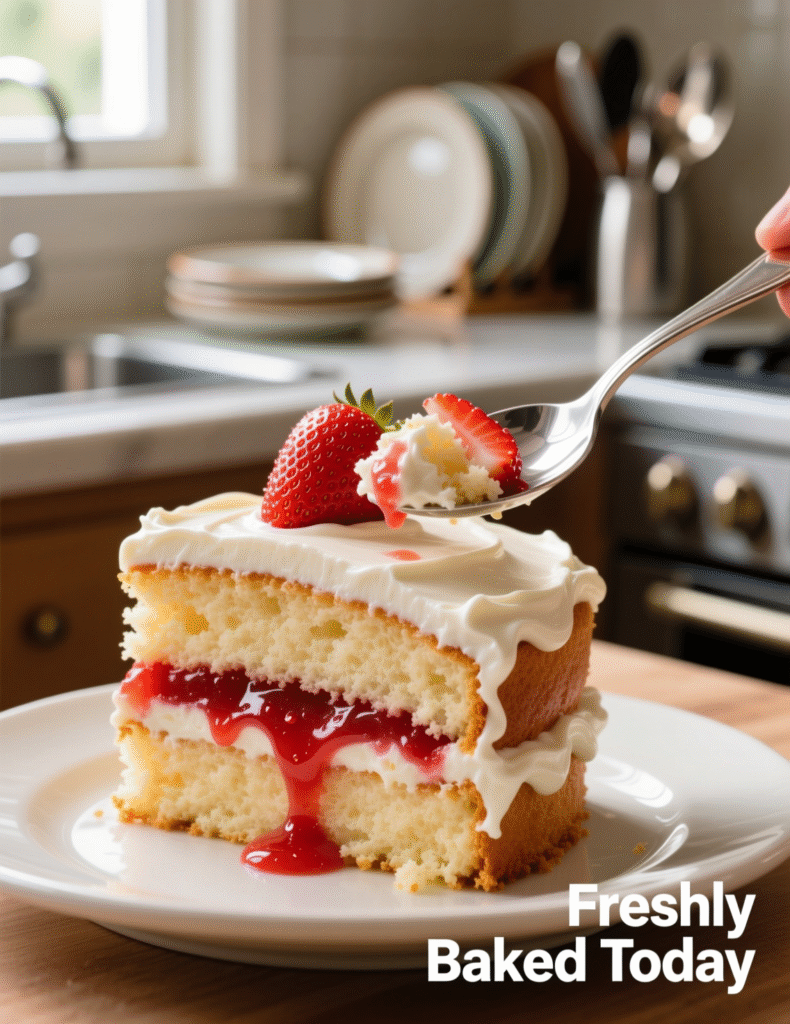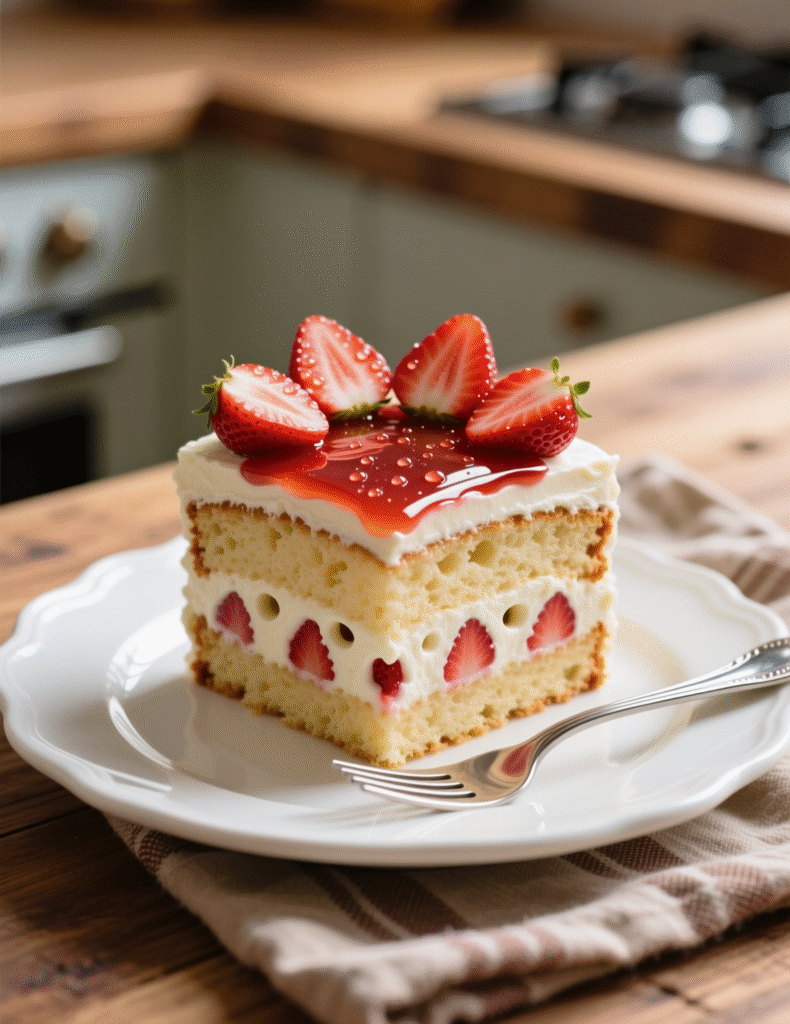If you’ve ever wanted a dessert that’s both indulgent and surprisingly easy, strawberry poke cake might just be your dream come true. This dessert isn’t just a sweet treat—it’s a phenomenon in the world of baking, combining moist cake layers, luscious strawberry flavors, and creamy textures that practically melt in your mouth. In this guide, I’ll break down everything you need to know to make a strawberry poke cake that serves 12, packed with insights from professional baking techniques, ingredient science, and flavor balancing that even seasoned chefs swear by.
What is a Strawberry Poke Cake?
A poke cake isn’t just a cake you poke. Sounds obvious but hear me out. Essentially, it’s a sponge or butter cake that’s baked, then “poked” with a fork or skewer, creating channels that absorb liquid flavorings—often gelatin, syrup, or pudding. For a strawberry poke cake, we typically use strawberry gelatin or fresh strawberry puree mixed with sugar and sometimes a bit of lemon juice. These channels let the flavor permeate the cake, making each bite explosively moist and flavorful.
It’s popular in American home baking, but professional chefs often tweak the base for texture and flavor sophistication. For instance, instead of a boxed mix, I recommend using a homemade sponge cake that balances lightness with slight chewiness, so it doesn’t get soggy when the strawberry infusion hits. And yes, you can experiment with mascarpone or cream cheese in the topping to elevate it into a semi-professional patisserie-level dessert.

Ingredients for 12 Servings
Precision matters when you’re baking for a group. Here’s a breakdown of what you’ll need:
- 2 ½ cups all-purpose flour, sifted for lighter texture
- 2 ½ tsp baking powder
- ½ tsp salt
- ¾ cup unsalted butter, softened
- 1 ¾ cups granulated sugar
- 4 large eggs, room temperature
- 1 tsp pure vanilla extract
- 1 cup whole milk, warm for better absorption
- 1 (3 oz) package strawberry gelatin
- 1 cup boiling water
- 1 can (14 oz) sweetened condensed milk
- 2 cups fresh strawberries, chopped (plus extra for garnish)
- 2 cups heavy cream, whipped
- Optional: 2 tbsp lemon juice to brighten strawberry flavor
A note from my experience: using room-temperature eggs and butter ensures a smoother batter, and warm milk helps the gelatin infusion penetrate more evenly. For the strawberry topping, ripe, juicy berries are non-negotiable—they make a huge difference in both taste and texture.
Baking the Cake Base
Start with preheating your oven to 350°F (175°C). Grease and flour a 9×13-inch pan. Mixing technique is critical here. Cream butter and sugar until pale and fluffy—this incorporates air and ensures a lighter cake. Then, beat in eggs one at a time, followed by vanilla. Sift the dry ingredients separately and fold them gently into the wet mixture. Avoid overmixing. Overmixing develops gluten, making the cake dense, which you def don’t want for a poke cake.
Pour the batter into your prepared pan, spreading evenly. Bake for 30-35 mins or until a toothpick comes out clean. Let the cake cool for about 10 minutes before you start poking. Cooling slightly but not completely is key—warm cake absorbs flavors better than cold cake, but too hot and it falls apart.
Preparing the Strawberry Infusion
This is where the magic happens. Dissolve the strawberry gelatin in 1 cup boiling water. Stir until fully dissolved, then let it cool slightly. Mix in the sweetened condensed milk—it makes the infusion creamy and adds body, preventing the cake from being overly sweet and watery. Optional: add a teaspoon of lemon juice to balance the sweetness. Pour evenly over the cake, using a fork or skewer to poke deep holes beforehand. Make sure you poke all around the cake—corners often get neglected, but they soak up the flavor like a sponge.
For chefs-level trick: if you want intense strawberry flavor, lightly puree fresh strawberries and fold them into the gelatin-condensed milk mixture. This adds real fruit essence, color, and texture.
Topping and Frosting
The topping is the final flourish. Whip heavy cream with a touch of sugar until soft peaks form. Some professionals add mascarpone or cream cheese for richer, more stable topping. Spread it generously over the cooled cake. Then, garnish with sliced strawberries, a few whole berries, or even a drizzle of reduced strawberry syrup. The visual contrast is as important as taste in professional plating—it signals freshness and indulgence.
Fun pro-tip: for a subtle crunch, toast finely chopped almonds or graham crackers and sprinkle lightly over the top. Texture contrast adds complexity and makes each bite interesting.

Storage and Serving
Strawberry poke cake is best served chilled. Cover tightly and refrigerate for at least 2-3 hours—overnight is ideal. This allows the flavors to meld fully. When serving, cut with a sharp knife dipped in hot water for clean slices. Each slice should reveal a pink, juicy interior dotted with strawberry flavor pockets. It’s visually stunning and a joy to eat.
Leftovers? They keep well in the fridge for 3-4 days. Flavor improves slightly after sitting, though texture might soften a bit. Avoid freezing, as the whipped topping and gelatin don’t handle freezing well—they separate and get watery.
Tips from the Pros
- Gelatin choice matters: Pure strawberry gelatin works well, but natural fruit purees with a bit of pectin yield more nuanced flavor.
- Cake texture: For a lighter cake, use cake flour or substitute a small portion of AP flour with cornstarch.
- Infusion technique: Use a chopstick or wooden skewer, poke every inch. Random poking leaves dry spots.
- Layering flavors: Consider brushing cake lightly with a strawberry syrup before pouring gelatin mixture—double punch of flavor.
- Visual appeal: Even distribution of strawberries on top enhances perceived value—people eat with their eyes first, especially at events or potlucks.
Common Misconceptions
Some people think poke cake is “cheater cake” because it uses gelatin or pudding. Not true. It’s just a different method of flavor infusion. Traditional cakes rely solely on the batter and frosting for taste, while poke cakes engineer flavor penetration through controlled infusion. Also, people sometimes assume more gelatin equals better flavor—too much gelatin creates rubbery pockets and clumps. Balance is crucial.
Another misconception: it must be boxed cake. While convenience mixes work, professionals and serious bakers prefer scratch cake. You control texture, flavor, and moisture. Scratch cake allows advanced techniques, like folding whipped whites into batter for extra airiness, which commercial mixes can’t replicate.
Why Strawberry Poke Cake Works
Strawberry poke cake appeals because it’s a textural symphony. Soft cake, creamy gelatin, whipped topping, and fresh fruit create layers of taste and mouthfeel. Scientifically, the moisture channels created by poking increase flavor diffusion and retention, which means each bite hits multiple sensory receptors. From a chef’s perspective, it’s an efficient yet impressive dessert—it looks complex but is actually simple to execute.
Variations and Professional Twists
- Strawberry Cheesecake Poke Cake: Add a layer of sweetened cream cheese before topping with whipped cream.
- Strawberry Shortcake Poke Cake: Use sponge cake, add fresh berries between layers, and lightly dust with powdered sugar.
- Chocolate Strawberry Poke Cake: Use cocoa powder in the batter for a chocolate-strawberry flavor profile—hits both fruity and cocoa notes.
- Alcohol-infused: For adult versions, fold a tablespoon of strawberry liqueur or Grand Marnier into the gelatin mixture.
Experimenting with these tweaks allows bakers to cater to different audiences while keeping the base recipe intact.
Conclusion
Strawberry poke cake is more than just a nostalgic dessert; it’s a professional-grade treat when made with care. Serving 12 requires precision in measurement, timing, and flavor balance. Key takeaways: always use fresh ingredients, control moisture levels, poke evenly, and never skip chilling. Professionals swear by small tweaks like using warm milk, folding in whipped whites, or adding a touch of mascarpone to the topping. Whether you’re baking for family, events, or a professional gathering, this cake delivers high impact with relatively low effort. It’s moist, flavorful, visually appealing, and utterly satisfying—a true showcase of how simple techniques elevate a dessert into something memorable.
FAQs
What is a poke cake?
A cake with holes poked in it to absorb flavorful liquids like gelatin or syrup.
Can I use boxed cake mix for this recipe?
Yes, but scratch cake gives better texture and flavor.
How many servings does this strawberry poke cake make?
It serves 12 people.
Can I use frozen strawberries?
Fresh strawberries are preferred, but thawed frozen ones work in a pinch.
Do I have to use gelatin?
Gelatin adds flavor and moisture, but fruit puree with pectin can be a natural alternative.
How long should I chill the cake before serving?
At least 2-3 hours, preferably overnight.
Can I freeze strawberry poke cake?
Freezing is not recommended as whipped cream and gelatin separate.
Can I make this cake ahead of time?
Yes, prepare a day in advance for best flavor infusion.
Can I substitute heavy cream in the topping?
Whipped cream is standard; mascarpone or cream cheese can be used for richness.
Why poke the cake before adding the gelatin mixture?
Poking creates channels so the flavor fully penetrates the cake.
Can I make a chocolate version?
Yes, add cocoa to the batter for a chocolate-strawberry variation.
How do I get clean slices?
Use a sharp knife dipped in hot water for smooth cuts.
Is this cake suitable for large events?
Absolutely, it’s visually appealing and serves 12 easily.
Can I add alcohol to this cake?
Yes, a tablespoon of strawberry liqueur or Grand Marnier works well.
How can I prevent soggy corners?
Poke evenly and ensure the gelatin mixture reaches all edges.

Marie Smith is a passionate recipe blogger, sharing easy, delicious, and creative culinary ideas that inspire home cooks to elevate everyday meals with flavor and simplicity.
